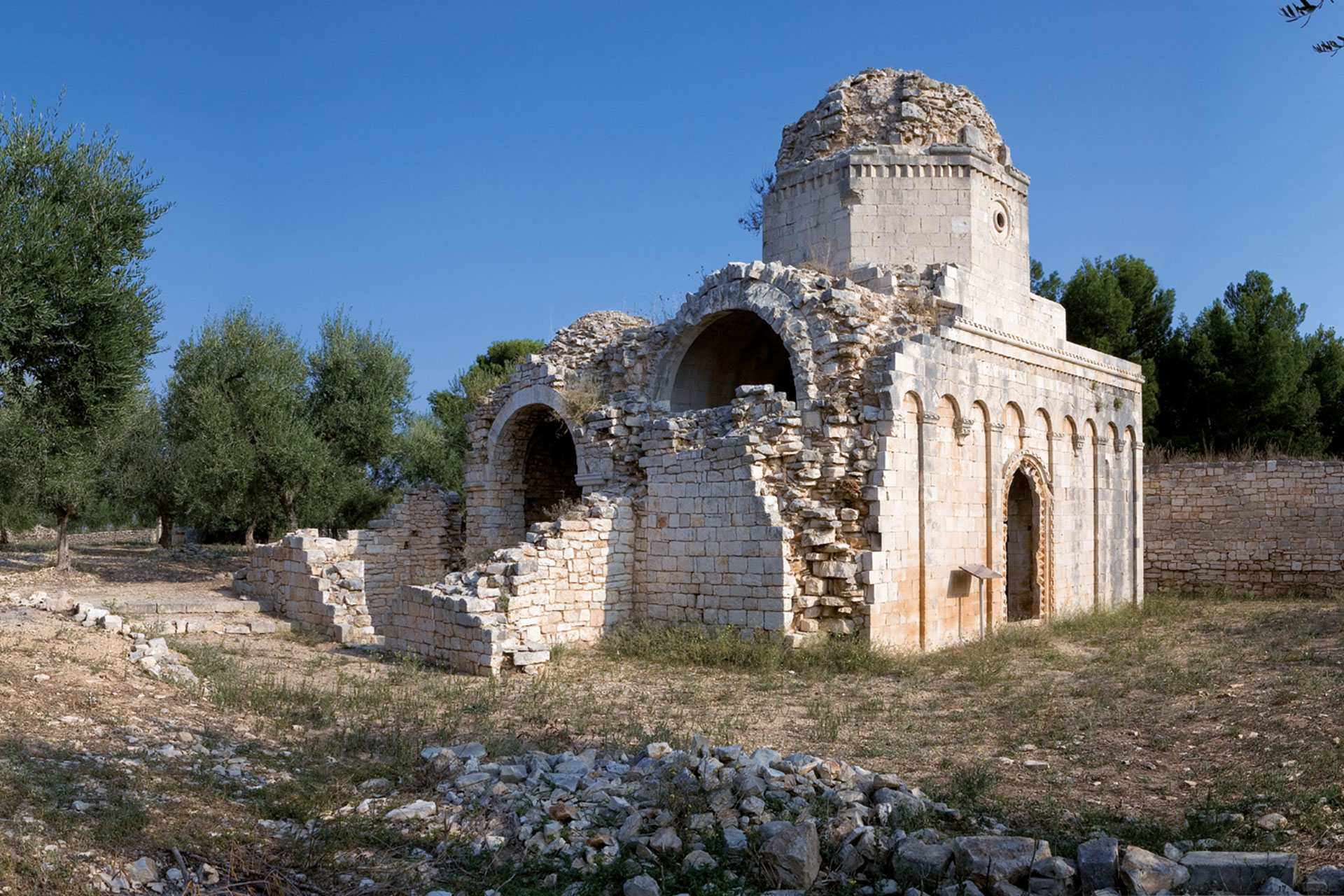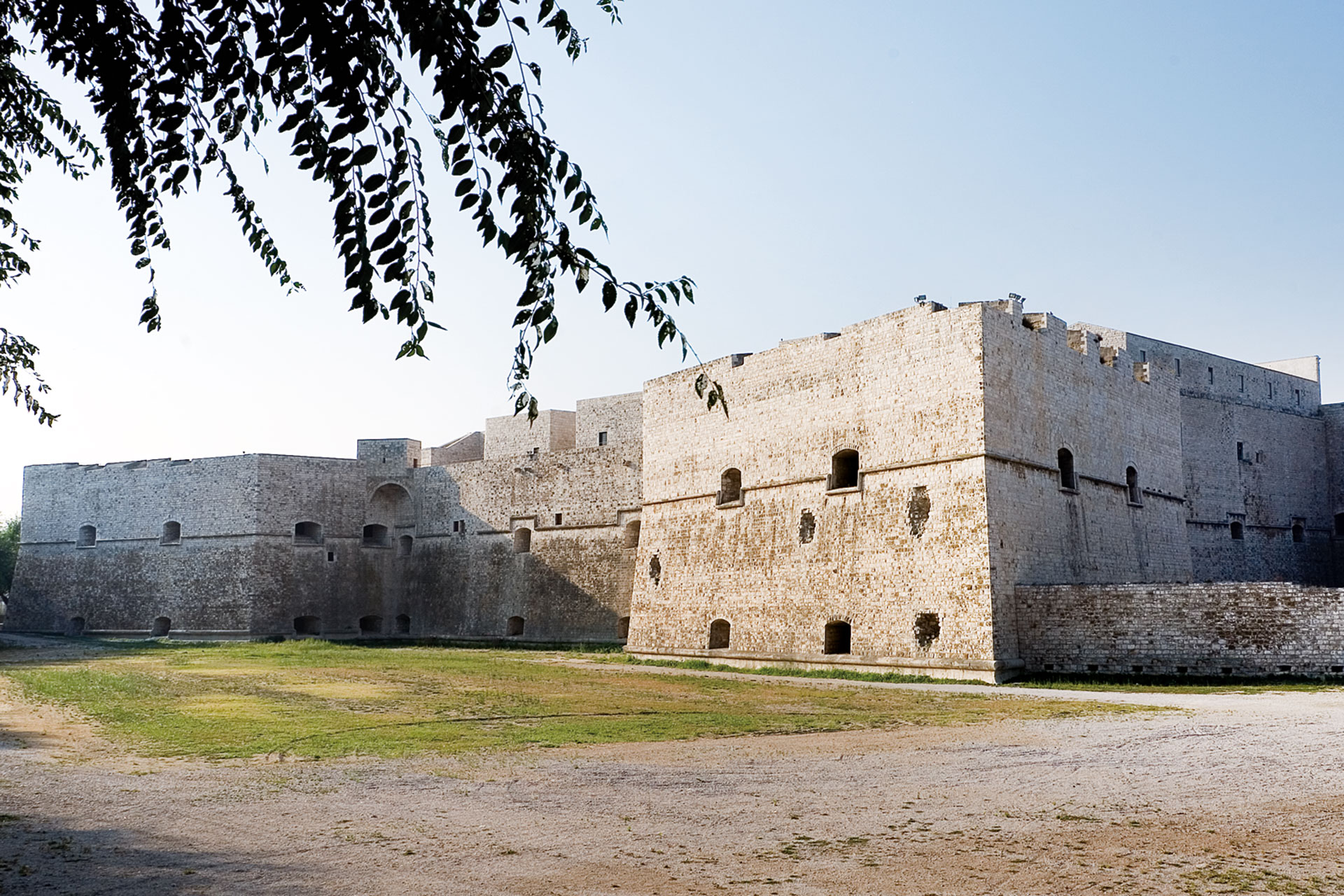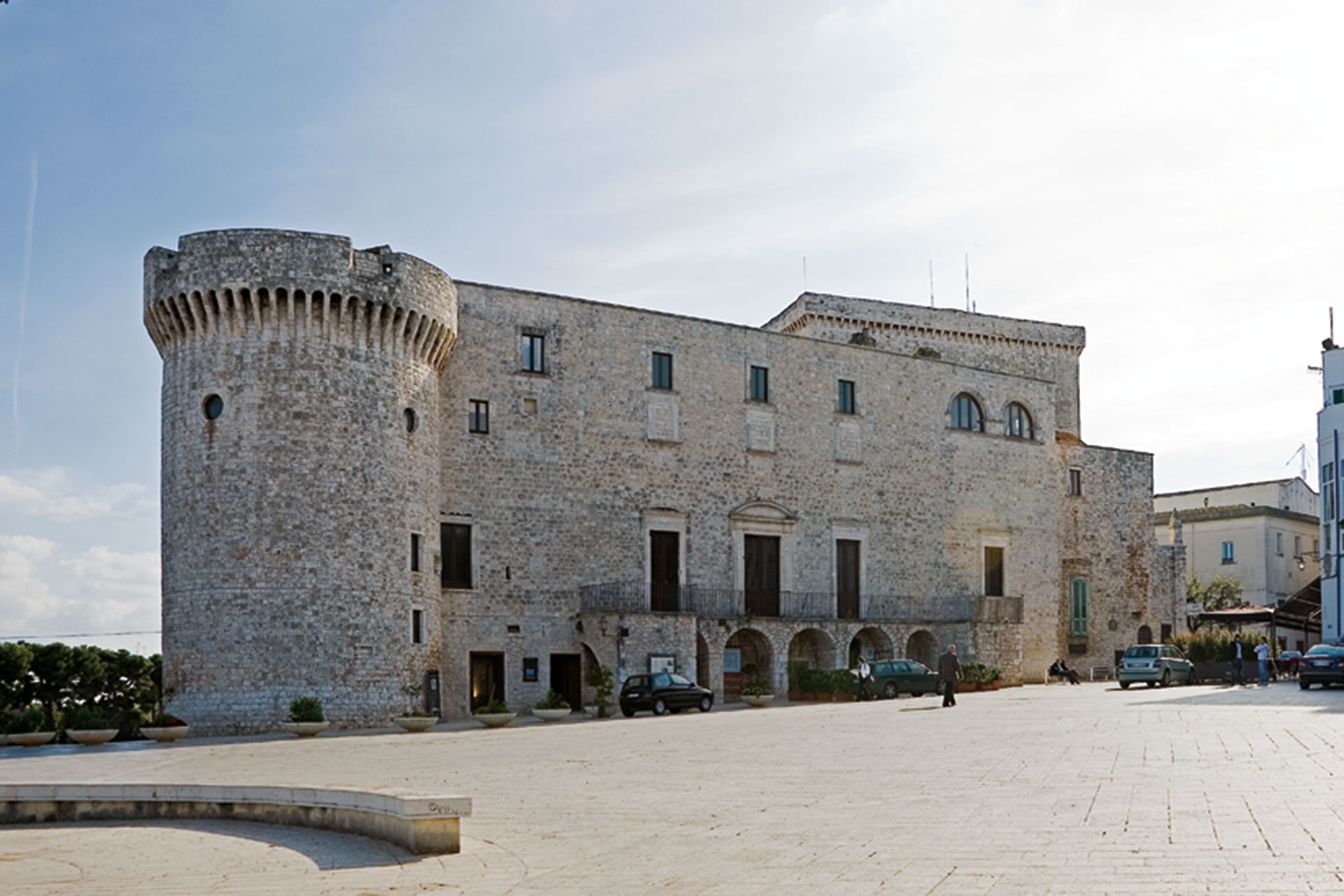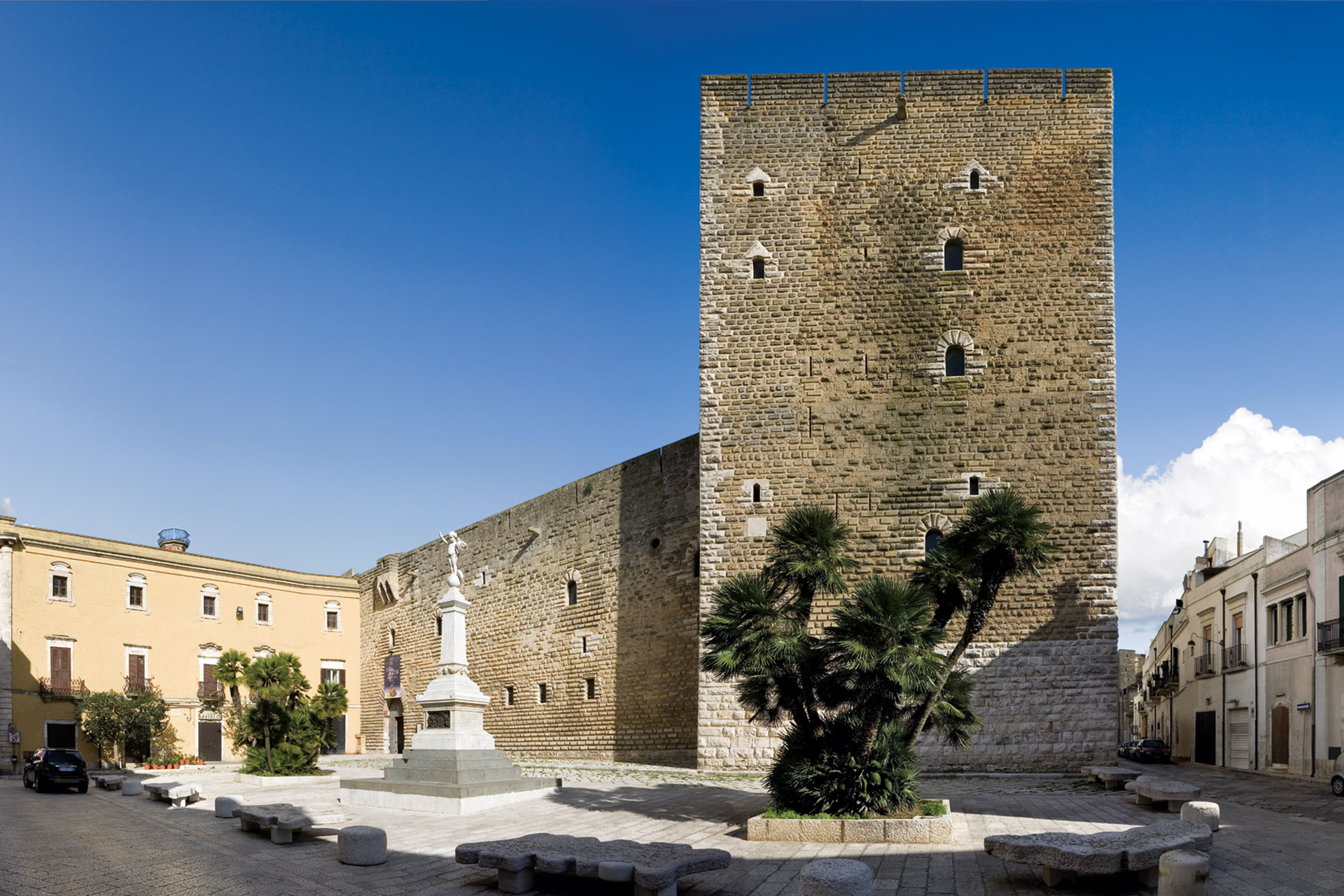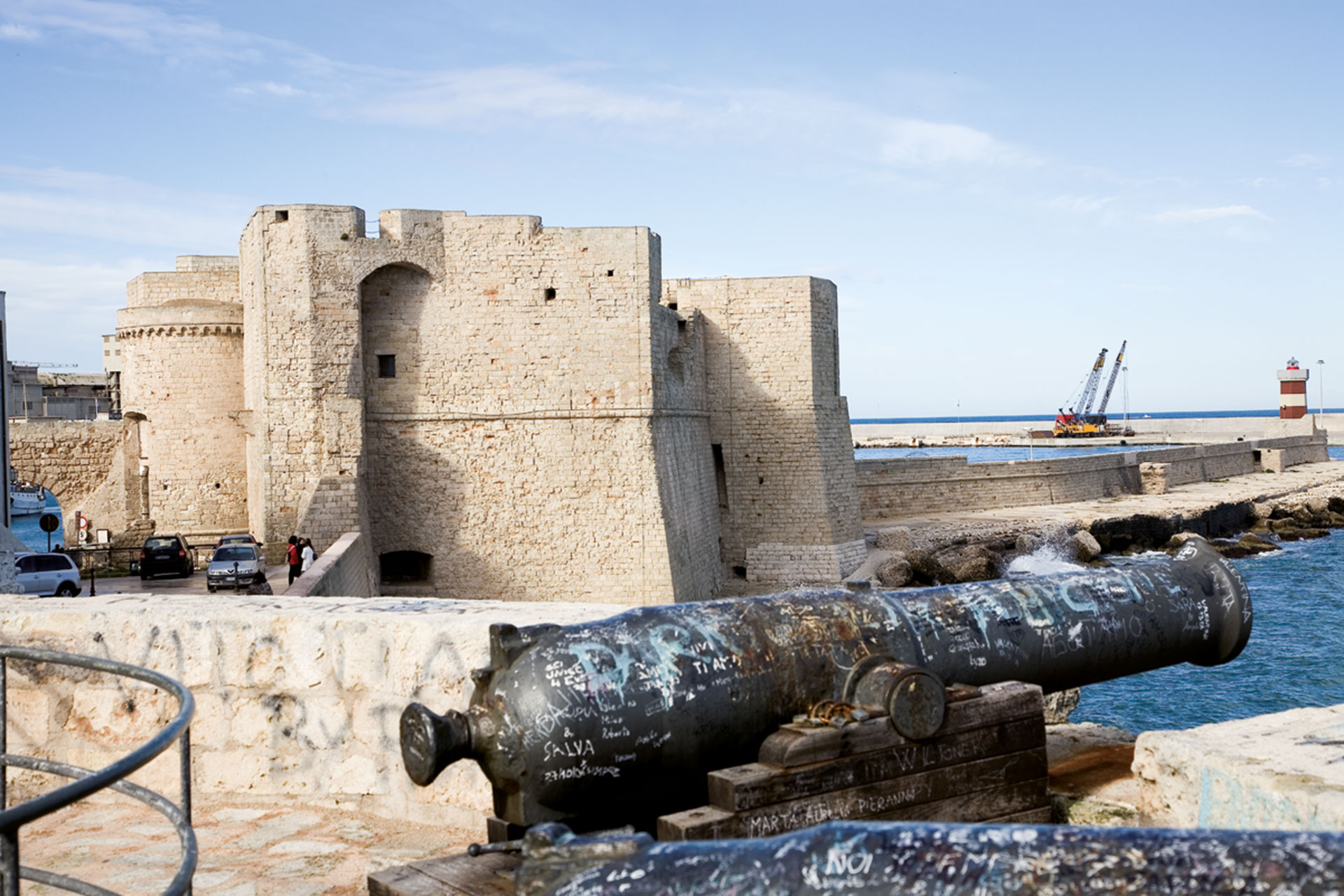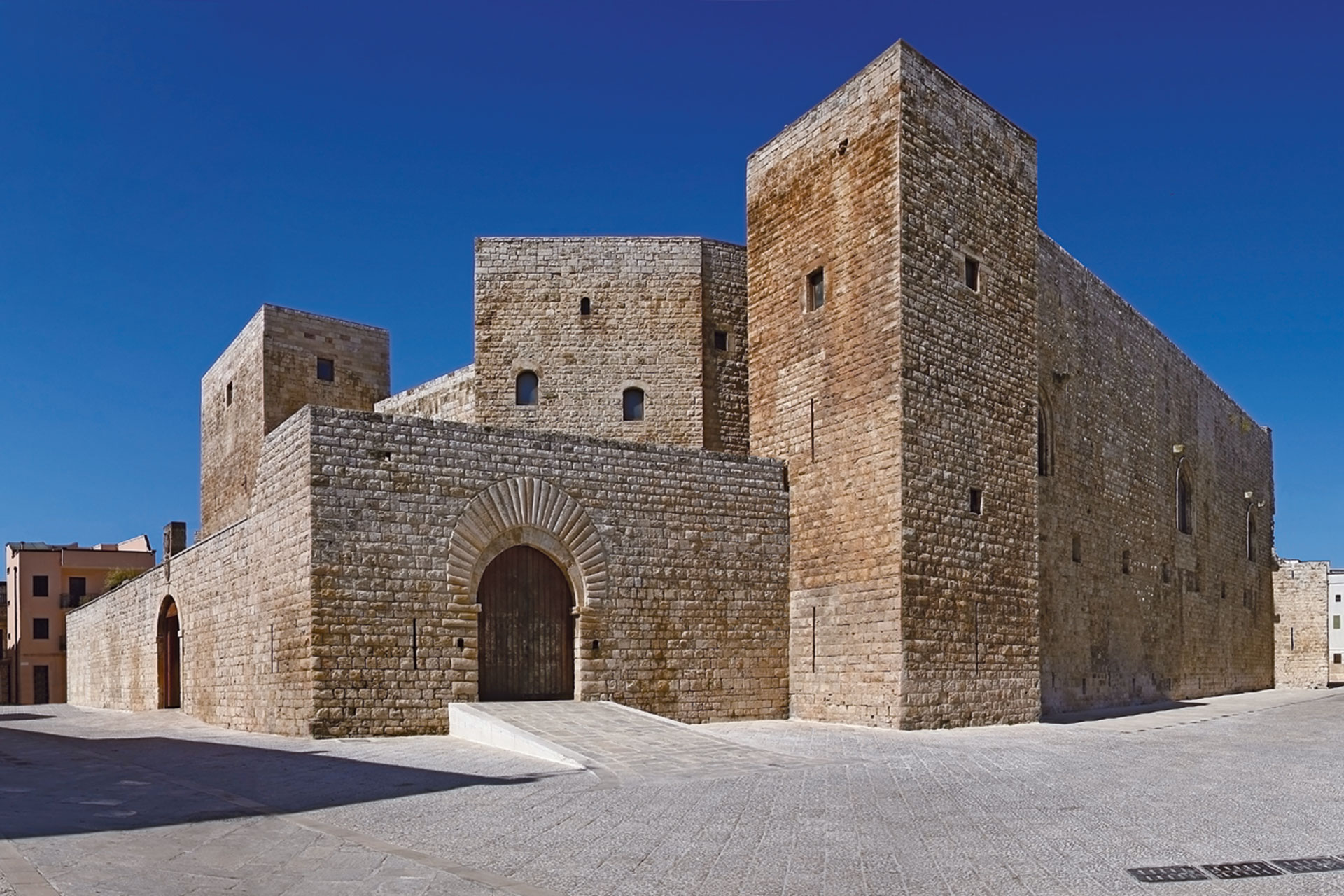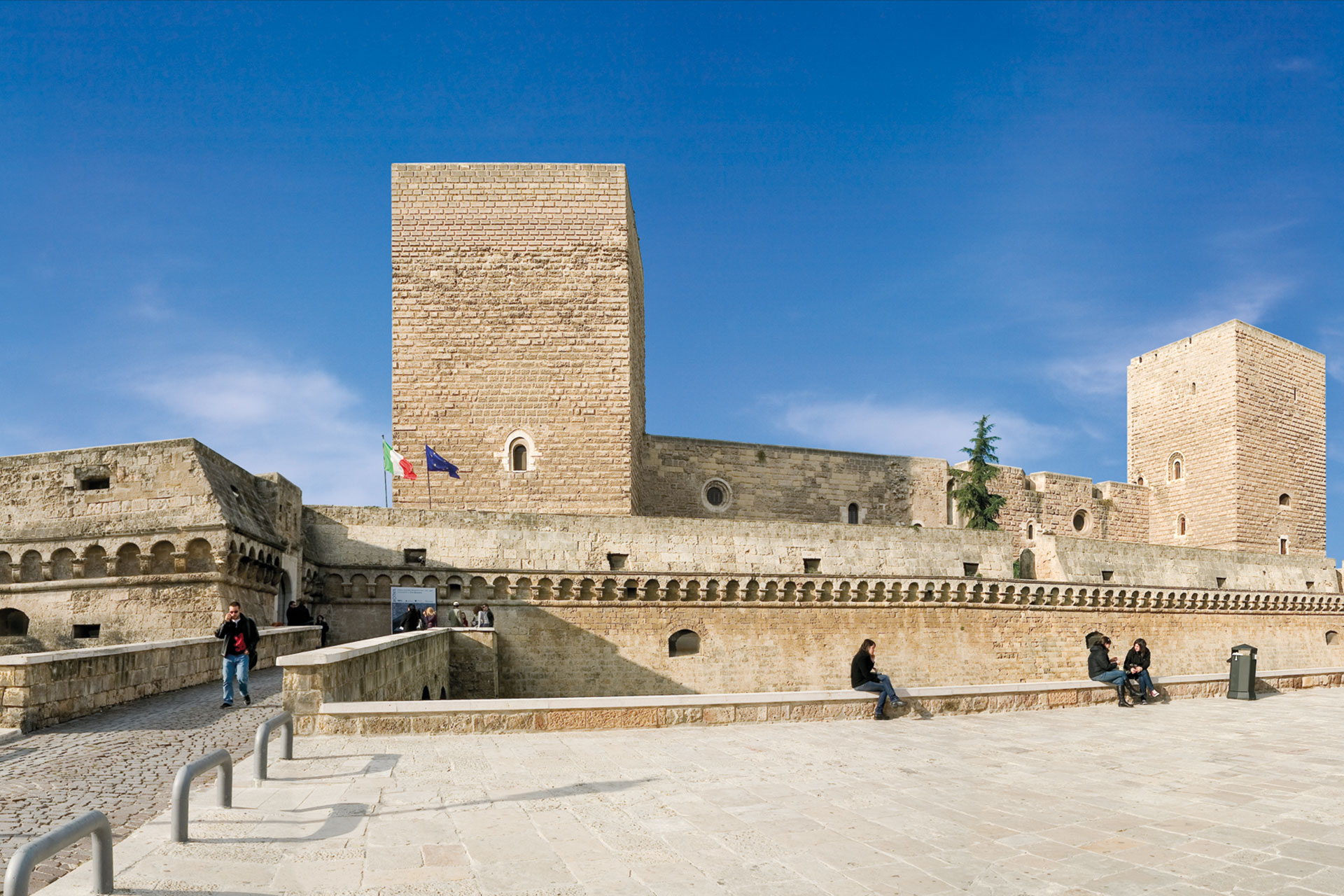The Medieval Castles
- on Tour
Wonderful and often mysterious emblems of the medieval events of the Terra di Bari and Bat, which have always been a crossroads of peoples, a meeting point of different cultures and traditions, a bridge connecting the East and the West, the castles and fortifications best express the strong identity of the various Apulian municipalities, which today are proud custodians of them.
An itinerary full of suggestion and history to experience the charm of a dive into the past…
You can visit in the metropolitan area of Bari the castles and fortifications of Bari, Bitonto, Sannicandro di Bari, Mola di Bari, Modugno, Butritto, Monopoli, Conversano, Gioia del Colle. In the northern area of the Batteria, you can visit the castles of Andria, Barletta, and Trani.
Here we offer a taste of our history or you can book a guided tour.
At the north-western end of the “old city”, we find the magnificent castle made of Apulian limestone with rusticated facing, whose northern side until about a century ago was washed by the sea. Its austere defensive appearance is due to its origins as a means of controlling the territory of Norman power over the conquered cities. Numerous restorations, as well as changing functional uses, have taken place up to the nineteenth century Bourbon period. The castle complex incorporates pre-existing Byzantine structures (10th century) including remains of living quarters and a church, below the floor level. The first Norman and then Swabian architectural nucleus can be identified within the bastioned perimeter of the 16th century walls with four square corner towers, of which three can be admired today: the tower to the north-east called “del Monaco or di San Francesco”, due to a legend that in the 13th century an encounter took place between Frederick II and a Saint; the “dei Minorenni” tower, to the south-west, used as a juvenile prison between the 19th and 20th centuries, and to the south-east, the “Semaforo” tower, for the ancient presence of military naval signaling installations. It was not easy to rebuild by the Norman ruler Ruggero II, especially due to the rebellious nature of the people of Bari, who damaged the building in the 12th century. In the Frederickian era, the structure was expanded and took on a trapezoidal layout, with bugnati curtain walls and defense towers around an elegant central courtyard, which underlined its residential and representative function. To this period belongs the refined double archivolt of the portal, an excellent demonstration of Frederickian Gothic art, with precious low reliefs, among which the imperial eagle with prey between its talons is noteworthy. In the southeast porch of the courtyard, one can admire columns with delightful capitals, with plant and animal figures, signs of an artistic style of eastern Romanesque origin, with Islamic influences. Further restorations were carried out in the Angevin period, especially on the seaward side. Isabella of Aragon and her daughter, Queen Bona Sforza, transformed the castle into an elegant fortified princely residence (16th century), with a bastioned perimeter wall with bastions and a deep moat. Today, the wonderful fortress is one of the city’s highlights, often a fascinating starting point for pleasant walks to discover the charming historic center, and a splendid location for artistic exhibitions or cultural and musical events, and home to the Gipsoteca, where plaster casts that constitute the most distinctive examples of Apulian sculpture are kept.
GIOIA DEL COLLE: Norman-Swabian Castle
In the white historical center of Gioia del Colle stands proud and elegant the beautiful castle, with its bichrome towers, steeped in its fascinating history. Due to numerous alterations during different eras, the structure remains one of the most indecipherable in Puglia. The fortress was built on a previous fortified Byzantine structure of the 11th century, with a defensive function during the Norman conquest, also thanks to its strategic position in controlling the road junctions between Bari and Taranto. With Riccardo d’Altavilla, the construction of the quadrangular donjon, the present southwest tower, the first nucleus of the fortress, took place, later enriched by two other towers, no longer existent, and connecting curtains around a courtyard. The phase of Frederick II’s expansion and remodeling from the 13th century is evident in the artistic details in Gothic style and Islamic influence of the structure, which contributed to giving the castle a more severe but at the same time light exterior appearance, given the coexistence of warlike architectural elements, walkways, loopholes, and red carparo ashlar masonry of ancient origins. The Swabian tower to the southwest, called “dell’Imperatrice,” with its asymmetrical monophores, oculars, and openings surrounded by multiform orientalizing frames of light limestone, has remained intact over the centuries. Further interesting Frederickian interventions are noticeable in the entrance hall with the large trapezoidal courtyard, refined by ogival arches with Romanesque capitals, but also in the suggestive “Sala del Forno,” at the base of the southeast tower, through which one accesses an underground room where the sad story of the beautiful Bianca Lancia is said to have taken place. She was loved by Frederick II and gave the emperor two sons. Popular tradition holds that the woman was imprisoned in this room and committed suicide, cutting off her breasts, which she had delivered to the sovereign together with the newborn Manfredi. In this prison, two roundnesses carved by an unknown stonemason on one of the walls are still admired today, which seem to testify to the terrible episode for those who visit it. The castle was then slowly transformed into a noble residence, with the Princes of Taranto (13th century), the counts Acquaviva d’Aragona (15th century), and the princes ‘de Mari (between the 17th and 19th centuries). Today, the National Archaeological Museum is located in the southern part of the castle, which preserves artifacts mainly from the famous nearby archaeological site of Monte Sannace.
CONVERSANO: The Comital Castle
The magnificent castle dominates the surrounding territory with gentle majesty, from its elevated position at the end of the historic center of Conversano. The charm of this magnificent structure, built where once stood a fortress of the medieval Cupersanum, is also influenced by the remarkable history that accompanied its modifications and various construction phases over the centuries, between the 11th and 19th centuries. From a control fortress in the Norman era, after a series of Altavilla-Bassavilla successions, it passed to the royal demesne of the Swabians, to the Brienne, Enghien, until it became a splendid Renaissance and then Baroque residence with Giovannantonio Del Balzo Orsini and the powerful fiefdom of the Acquaviva D’Aragona counts. Today, the castle preserves its original trapezoidal plan, imprinted in the Norman era, and is distinguished by the refined wall cladding of limestone blocks and by the four towers crowned by a similar cornice with battlements. The quadrangular master tower, probably dating back to the mid-11th century, is now reachable from the late Baroque monumental entrance on Piazza della Conciliazione. The powerful tower, with its 25 meters height and divided into three levels, rests on the remains of megalithic walls. Admiring the noble eastern facade of the residence, one can notice the symmetrical Angevin square tower, adorned with Gothic windows and a belvedere with late-Renaissance loggias.
Book Your Stay
Antico Corso • Sammichele di Bari
-
POLIGNANO A MARE
Polignano Holiday Home is a holiday home located in the center of the magnificent city of Polignano a Mare, completely renovated in full respect of the typical characteristics of the place. The stone arches and modern and functional furnishings make a good sight in the Home Holiday. Equipped with all comforts: kitchen, washing machine, microwave oven, crockery, hygiene products, sheets, towels and shower towels.Price: €220.00night -
Antico Corso 74
SAMMICHELE DI BARI
The Amaranto Room is a Double Room with a Jacuzzi hydromassage tub with chromotherapy with the possibility of adding a third bed. A room with a warm and welcoming color, with a double bed and the possibility of adding a third bed, ideal for a fairytale stay for a couple or a couple with a child. The Amaranth Room is equipped with bathroom with shower, air conditioning, minibar, TV, built-in wardrobe. A furnished room with a relaxation corner, ideal for an enchanting stay in Puglia.Price: €120.00night -
Antico Corso 74
SAMMICHELE DI BARI
The Gold Room is a Double Room with a Jacuzzi hydromassage tub with chromotherapy which can be used with a supplement of € 40 on the basic price. An enchanting room, with a double bed, ideal for a couple's fairytale stay. The Gold Room is equipped with bathroom with shower, air conditioning, minibar, TV, built-in wardrobe. A room furnished with art objects and in golden colours, ideal for a romantic stay in the magnificent land of Bari.Price: €80.00night -
Antico Corso 74
SAMMICHELE DI BARI
The Green Room is a family room with all the comforts. An apartment with 4 beds, 2 bedrooms, one of which is double and a living room with sofa bed. An apartment equipped with a kitchenette and crockery to taste the typical Apulian food and wine. A home furnished with taste and simplicity, ideal for a peaceful stay and for moving around easily while visiting the tourist beauties of Puglia.Price: €160.00night




